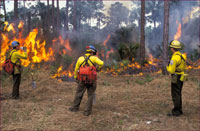Dear Umbra,
My husband says that Rush is blaming the Sierra Club for the huge forest fires raging in Colorado and Arizona. He says that because environmentalists oppose logging, the forest is too full of fuel. I told him that as far as I know, the Sierra Club is really trying to prevent logging in roadless areas and wilderness areas, not areas where people are living and building developments. But he pointed out that with the fires the size they are, they could have burned through some of both kinds of areas. I also told him that the U.S. Forest Service’s own policy of stamping out forest fires had the most to do with the unusual build-up of tinder in the forests, and drought plays a part as well. So my question is: Are the forests that are burning previously logged ones or never logged ones, and what are the proximate and more distant causes? I have always thought Rush had his head up his butt, but I need more logical arguments to give my husband, whom I have to admire for at least trying to keep an open mind.
Maggie
Dearest Maggie,
A proper answer to your question would rival Anna Karenina in length, because it would require recounting the long history of forest management in the U.S. and explicating the political tinderbox that is logging politics, especially in the West. But here’s the short version: Rush argues that forest fires are raging in Colorado and Arizona because we aren’t logging, leaving the forests full of fuel. Well: A forest is by definition full of wood, a favorite fuel since Prometheus.

Fighting fire with firefighters.
Photo: USFWS.
Fire is a natural event in most forest ecosystems, serving to create food and space for new growth. Certain tree seeds need fire in order to germinate. But natural forest fires are briefer and cooler than the raging infernos that have gobbled land and grabbed headlines this summer. Why? Because logging and human development have interrupted the forest cycle, leading to more destructive fires.
Here’s how it works: Commercial loggers take out large, healthy trees, with their fire-resistant thick bark, and leave behind a mess of bracken, smaller trees, undergrowth, and tree leftovers known as slash. With the larger canopy trees gone, the remaining stuff can become very dry in the summer. You get the picture: one giant pile of kindling. Fire suppression near human development also creates a pile-of-kindling effect, as there are no natural fires to burn out the naturally occurring dead trees, undergrowth, and so forth. When fires, lit by lightning or people, catch in these conditions, they burn hotter and faster.
Both virgin and logged lands in the West have burned this summer, but the Sierra Club is not responsible for these fires; moreover, its valiant efforts to preserve wilderness areas in our national forests are making scant headway against the “Come and get it, boys!” policy of President Bush. (Incidentally, when I first read your letter, I thought you had made a typo — hitting R instead of B. Makes sense both ways.)
Smokin’,
Umbra

